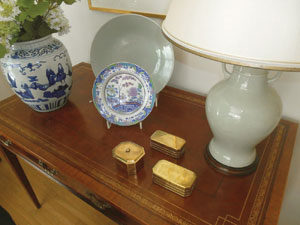
When I taught Decorative Arts at a SBCC, I had a room full of English speaking students, with one Japanese student, Haruto, who knew only a few English words. I didn’t worry much about him understanding our classes, because I illustrated my lectures with slides (Remember them?). Yet he found it difficult to grasp my lectures on the material culture, furniture and art of the 1960’s, especially the psychedelic organic forms of Pop Art and Poster Art.
As fate deemed it, I drove my son’s 1969 orange Chevy Camaro Super Sport to school that evening. During the break I took young Haruto out to the parking lot. It struck me to use that car as a teaching tool for the art of the 60’s.
I explained that each era has a “shape.” Everything during that era partakes of that shape, and that shape informs clothing, furniture, art, and, yes– cars of that era. I asked Haruto to draw his hand through the air and make the shape of the Camaro. As you know, a 1969 Camaro looks a little like the shape of a shark, or a platform shoe, or a man with a tight suit, large lapels and an afro, or a woman with hip hugger bell bottoms. Haruto immediately got it – 1960’s art henceforth became easy for him to understand.
Every person’s aesthetic, like pieces every era, has a certain “shape” which are contained in favorite pieces which they respond to. And after seeing somebody’s home each day for 26-years, I now recognize the line or shape of a person’s taste.
Last week I entered DM’s house in the San Roque area of Santa Barbara, a little perfect gem set in partiera bushes and a well-manicured garden, with pergolas built with vines and flowers at the back. The interior, although small, exuded perfection. Everything spoke of his delicate artistic flowing Arabesque linear aesthetic, somewhat organic but restrained, set in winter colors set off by intense white, blue and silver. DM is a master of understanding what he likes to look at, and everything, no matter how unique, fits together.
Here’s sampling of the variety of what I saw in his home:
- Inuit sculpture
- 18th century British pottery
- contemporary Canadian painter
- Chinese celadon
- 18th century Brown furniture
- bamboo seating from the 1950’s
- Quimper faience
Why can some people pull diversity like this off?
They know what their “shape” is, and they stick to it.
I am presently working on DM’s appraisal for insurance purposes. Not only does he make space flow in that little house, he owns valuable art which he bought when his artists were not expensive. He knows the line or shape which pleases him. So he has Canadian naïve art and Canadian realist art and everything is finely crafted, and now worth a ton of money.
DM asked me to help find buyers for those items he deemed presently unworthy, thus he relegated them to his little garage. And this is the point of this article: DM became a connoisseur.
When someone discards things not as good as what they presently collect, they get rid of the bottom one-third of their collection. Then I know I can crown them with a connoisseur’s tiara. They move up and refine their collection. They learn more about what their line/shape is, and they follow that into their collection in a deeper, more understandable way. They study to get there.
Thus we learn how a connoisseur differs from a collector, and we learn that if you know your “line” everything you love will work together, because it’s all your shape. Think of very different objects you love and think of what their common shape is, and you will have an insight into what your personal aesthetic is. Once you recognize it, you can stick to it. Think of a really good pal who always knows the right hostess gift for you. It’s sometimes easier for people who have “good eyes” to recognize YOUR shape.
If you group together three things you LOVE and study their commonality, you will discover your unique line.